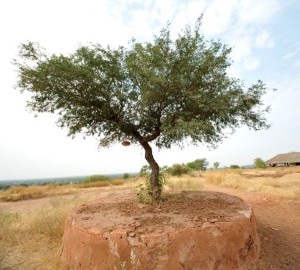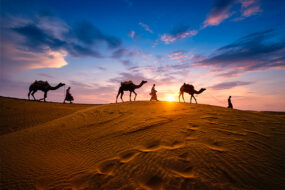Khejri ( Prosopis cineraria) covers about two-thirds of the total geographical area of the State and and is of immense significance culturally and economically. The tree supports rural economy like no other wild vegetation does. Some must have heard about this tree in our great epics Mahabharata and Ramayana. The tree that represents the Goddess of Power is worshiped by Pandavas who hid their weapons in it during Agyatavasa as well as Rama before advancing his army to kill Ravana. But the greatness of Khejri tree (Prosopis Cineraria/शमी) is not limited to this mention.
An evergreen thorny tree which can grow in very harsh climate & in poor soil, well adapted to the arid conditions and also stands well to the browsing by animals. Khejri withstands hot winds & dry seasons and exhibits considerable drought hardiness. The tree reproduces freely by root suckers and establishes well from seeds too. The seeds should be soaked for 24 hours before plantation. Khejri Plant, The tree is evergreen or nearly so. It produces new flush leaves before summer. The flowers are small in size and yellow or creamy white in colour, appear from March to May after the new flush of leaves. The pods are formed soon thereafter and grow rapidly in size attaining full size in about two months time.

The fruit of the tree is eaten as sangria, cooked as a delicious vegetable and mixed with the fruits of “Kair,” another dominant vegetation across the desert region. It is rich in proteins and dry sangria is sold at Rs. 300-400 a kg. The dead leaves of the tree are natural fertilizers. Other parts are fed to the cattle as it increases the milk yield.
A branch or two on the top of the tree is left uncut, which helps rejuvenate the tree within a few months.The Desert Tree, as it is also known as, was the lifeline of the people in Western Rajasthan in the earlier times. It provided firewood and even acted as a cash crop.
The root cause of decline in the Khejri cover is its excessive lopping (cutting of branches), which all farm owners do annually to procure its fruit, pods, leaves, branches and twigs.
Scientists at Jodhpur-based Arid Forest Research Institute (AFRI) have assessed that Khejri mortality ranged from “18.08 per cent to 22.67 per cent with an average mortality of 20.93 per cent” in Jodhpur, Nagaur, Churu, Sikar, Jhunjhunu and Jalore districts.



